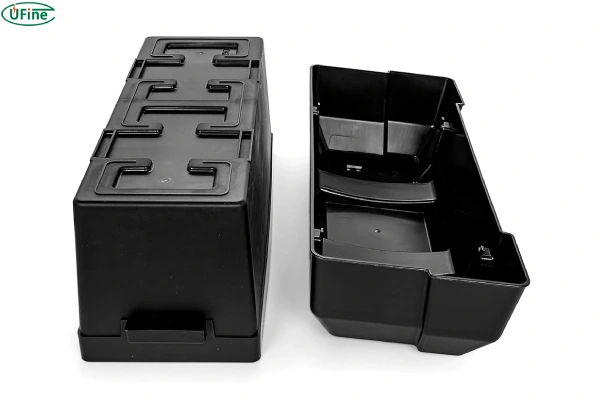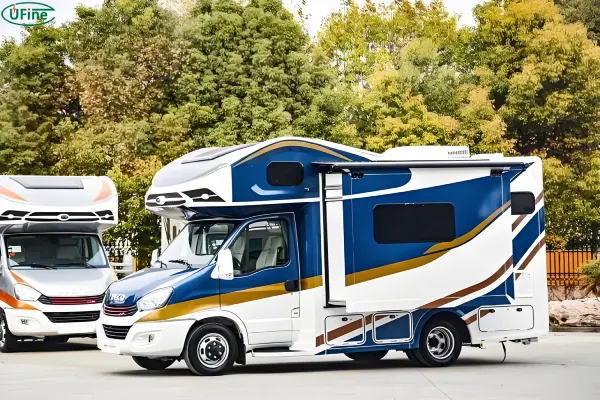
The heart of any RV’s electrical system is its battery bank. These batteries power everything from lights and appliances to your entertainment system and even your air conditioner. But how do you protect these vital components and ensure they function reliably? That’s where an RV battery box comes in. This essential component provides a secure, weatherproof, and accessible home for your batteries, ensuring they perform their best and last longer.
Part 1. What is an RV battery box?

An RV battery box is a sturdy, weatherproof enclosure designed to house and protect your RV batteries. It serves as a vital link in your RV’s power chain, ensuring reliable performance and long battery life. Here’s what makes an RV battery box essential:
- Protection: RV battery boxes shield your batteries from the elements. Rain, snow, dust, and even extreme temperatures can damage your batteries, leading to premature failure. A good battery box acts as a barrier, keeping your batteries dry, clean, and functioning optimally.
- Ventilation: Batteries release hydrogen gas during charging and use. This gas is flammable and can be hazardous if it builds up inside the box. RV battery boxes are designed with vents to allow this gas to escape safely, preventing potential hazards.
- Security: RV battery boxes often come with locks, deterring theft and vandalism. This is especially important when your RV is parked in remote areas or overnight at campgrounds.
- Accessibility: A well-designed battery box allows for easy access to your batteries for maintenance and replacement. This makes it easier to check battery levels, clean terminals, or swap out batteries when necessary.
What Everyone Using Lithium Batteries for RV Should Know
Part 2. Types of RV battery boxes
RV battery boxes come in various shapes and sizes, each designed for specific needs and RV layouts. Here’s a breakdown of the most common types:
- Under-Chassis Battery Boxes: These boxes are mounted underneath the RV chassis, tucked away from view. They offer a secure and discreet location for your batteries, minimizing the risk of damage or theft. However, accessing batteries under the chassis can be inconvenient, especially in tight spaces.
- Side-Mount Battery Boxes: These boxes are mounted on the side of the RV, often near the wheel well. They offer easy access for maintenance and replacement, making them a popular choice for many RVers. However, side-mount boxes can be more susceptible to damage from road debris and weather.
- Rear-Mount Battery Boxes: These boxes are mounted at the rear of the RV, often near the spare tire. They offer a convenient location for accessing batteries, especially if you have a rear-entry RV. However, rear-mount boxes can be susceptible to damage from road debris and weather, especially in areas with heavy rain or snow.
- Custom Battery Boxes: These boxes are designed to fit specific RV models and layouts, offering a tailored solution for your needs. They can be more expensive than standard boxes, but they offer a perfect fit and optimal functionality.
Part 3. Key parameters
When selecting an RV battery box, consider these key parameters to ensure it meets your needs:
- Size: The battery box should be large enough to accommodate your batteries comfortably, allowing for proper ventilation and access. Measure your batteries and consider the size of your RV’s battery compartment before making a purchase.
- Material: RV battery boxes are typically made from aluminum, fiberglass, or plastic. Aluminum is durable and corrosion-resistant, while fiberglass is lightweight and strong. Plastic boxes are generally the most affordable but may not be as durable.
- Ventilation: Adequate ventilation is crucial for preventing the buildup of hydrogen gas. Look for boxes with multiple vents strategically placed to ensure proper airflow.
- Security: If security is a concern, consider a box with a lock and a sturdy construction. Some boxes even come with tamper-resistant features.
- Accessibility: Choose a box that provides easy access to your batteries for maintenance and replacement. Consider the location of the box and the ease with which you can reach the batteries.
- Installation: Think about the installation process. Some boxes are easy to install, while others may require professional help. Consider the complexity of the installation and your own DIY skills.
Part 4. RV battery box price
1. Basic Plastic RV Battery Boxes ($20 – $50)- Material: Usually made of durable plastic (polyethylene or polypropylene).
- Features: Often include
- Use Case: Suitable
- Material: More robust construction with UV-resistant materials.
- Features: These may offer better water resistance, ventilation, and built-in mounts for securing the battery.
- Use Case: Ideal for RV owners who need enhanced durability and protection for larger, higher-capacity batteries.
- Material: Made of steel or aluminum, providing stronger physical protection and better heat dissipation.
- Features: Often come with locking mechanisms, enhanced ventilation, and custom mounting brackets.
- Use Case: Suitable for more rugged environments or larger RV setups that require extra protection from the elements, vibrations, or theft.
- Material: High-quality aluminum or stainless steel.
- Features: May include custom sizing, multiple battery compartments, heavy-duty locking systems, and advanced features like external ventilation or integrated wiring options.
- Use Case: Designed for RV setups with complex electrical systems, lithium batteries, or high-end RV conversions.
Part 5. How to choose a suitable RV battery box?
Choosing the right RV battery box involves considering your specific needs and preferences. Here’s a step-by-step guide to help you make the right decision:
- Determine Your Battery Needs: Start by identifying the type and size of batteries you need for your RV. This will help you narrow down the choices and select a box that can accommodate them.
- Consider Your RV Layout: Measure the available space in your RV’s battery compartment to ensure the box fits comfortably. Also, think about the location of the box and how easy it will be to access your batteries.
- Prioritize Maintenance: Think about how often you will need to access your batteries for maintenance. Choose a box that provides easy access, especially if you plan to do your own battery maintenance.
- Assess Security Needs: If you are concerned about theft or vandalism, consider a box with a lock and a sturdy construction.
- Set a Budget: Determine how much you are willing to spend on an RV battery box. Consider the features and materials you need and choose a box that fits your budget.
The right choice depends on your specific RV setup, battery type, and the level of protection you need.
Part 6. Installation and maintenance:
Installing an RV battery box is a relatively straightforward process. However, it’s important to follow the manufacturer’s instructions carefully. Here are some general tips:
- Choose a Suitable Location: Select a location that provides adequate ventilation, protection from the elements, and easy access for maintenance.
- Secure the Box: Use appropriate fasteners and mounting brackets to secure the box to your RV.
- Connect the Batteries: Connect your batteries to the box using the appropriate cables and terminals. Ensure all connections are tight and secure.
Maintaining your RV battery box is essential for ensuring its longevity and protecting your batteries. Here are some maintenance tips:
- Clean the Box Regularly: Remove dirt, debris, and corrosion from the box and the batteries.
- Check for Damage: Inspect the box for any signs of damage or wear and tear.
- Maintain Battery Connections: Ensure all battery connections are tight and secure.
- Ventilate Properly: Ensure the vents are clear and functioning properly.
Part 7. Final words
Choosing the right RV battery box is an essential step in ensuring reliable power and protecting your batteries. By considering your needs, budget, and RV layout, you can find the perfect battery box to power your adventures. Remember to prioritize ventilation, security, and accessibility, and don’t forget to maintain your box regularly to keep your batteries safe and performing at their best.
Related Tags:
More Articles

What is the Difference Between Silver Zinc Battery vs. Lithium-ion Rechargeable?
Compare silver zinc and lithium-ion rechargeable batteries: energy density, cycle life, safety, cost, and uses in drones, medical devices, EVs, and electronics.
What are Watts and Watt Hours in Battery?
Understand watt vs watt-hour in batteries: key differences, how to calculate capacity, and why they matter. Includes free comparison table.
Best 10 Blood Pressure Monitor Battery Review: Finding the Most Reliable
Are you looking for a reliable Blood Pressure Monitor battery? Here is a complete guide with the top 10 best blood pressure monitor batteries.
Bluetooth Headphone Battery Guide: All You Need to Know
Maximize headphone battery life with expert tips! Learn how to charge, check, troubleshoot, and choose the best bluetooth headphone battery in 2025.
LiFePO4 Battery VS. Lithium-ion Polymer Battery: Which One Is Best?
Comprehensive comparison of LiFePO4 vs Lithium Ion Polymer batteries: energy density, safety, lifespan, cost. Find out which battery suits your needs in 2025.



